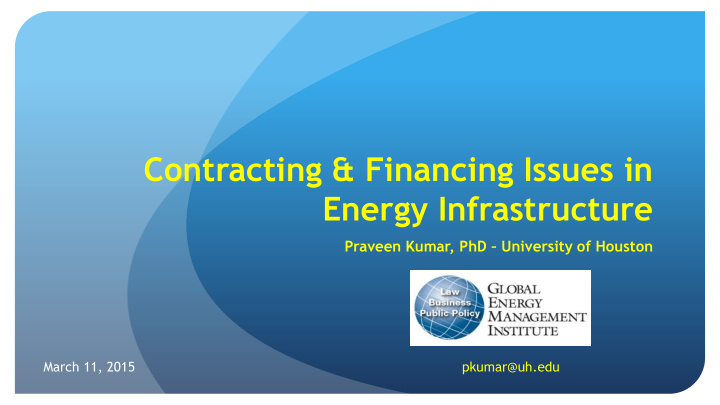



Contracting & Financing Issues in Energy Infrastructure Praveen Kumar, PhD – University of Houston March 11, 2015 pkumar@uh.edu
Oil and Gas Infrastructure Extraction Transportation Transformation (Refining, LNG etc) Storage Export Facilitation
Economic & Financial Incentives: Basic Questions What factors most impact the economic and financial incentives to invest in infrastructure? Specifically, what are the economic impediments to infrastructure development and performance? Suboptimal contract design Difficulty in attracting investment from banks and capital markets Business structures not conducive to investment in infrastructure growth and efficiency Suboptimal regulatory frameworks
Contractual Issues New natural gas pipeline, terminal, and storage infrastructure investment is typically based on contract design geared for low risk of cash flows: Long-term firm commitments (10 years or more) from gas suppliers Low volume risk (no accommodation for “interruptible service” preferences of certain buyers Fee-based Contracts between producers, suppliers (aggregators), and buyers are typically short term Major buyers (such as power generators) want “interruptible service” contracts to accommodate generation geared to serve very short term demand peaks.
Financing Issues Ultimately, investment in energy infrastructure requires financial resources allocated by capital suppliers (banks, institutional investors, etc.) Investment in infrastructure therefore needs to be competitive in the sense of expected after-tax returns exceeding the required risk-based cost of capital Investment in energy infrastructure will depend on Whether asset ownership structures allow high after-tax returns with relatively low risk? Overall portfolio environment: What is the opportunity cost of capital in energy infrastructure investment? Strategic imperatives: Is investing in infrastructure part of a broader strategy in the unconventional hydrocarbon space?
Asset Ownership Issues The Master Limited Partnership (MLP) asset ownership structure has been dominant in midstream infrastructure because of special tax protection and cash flow pass through (low risk) features Will the MLP continue to be the optimal ownership structure to attract investors in a changing market and economic environment? What are the pros and cons of alternative ownership structures such as Yieldcos? What are the incentives of other infrastructure-focused entities, such as private- equity backed midstream companies, infrastructure funds, foreign investors, commodity-based hedge funds? Does ownership of midstream infrastructure firms form a part of broader M&A strategy to enter/enhance existing position in the shale play?
Regulatory Issues Is there a regulatory “fix” that can address the contractual issues? Example: Bring power generation and natural gas industries under the same regulatory regime? Caution: Contract design is endogenous --- driven by the commercial interests of parties --- and cannot be realistically mandated through regulatory fiat (the curse of unintended consequences !) Example: The desired contract attributes of infrastructure providers will be largely be determined by the market environment (commodity price risk, expected returns) and their debt structure (matching debt contract horizons)
Recommend
More recommend